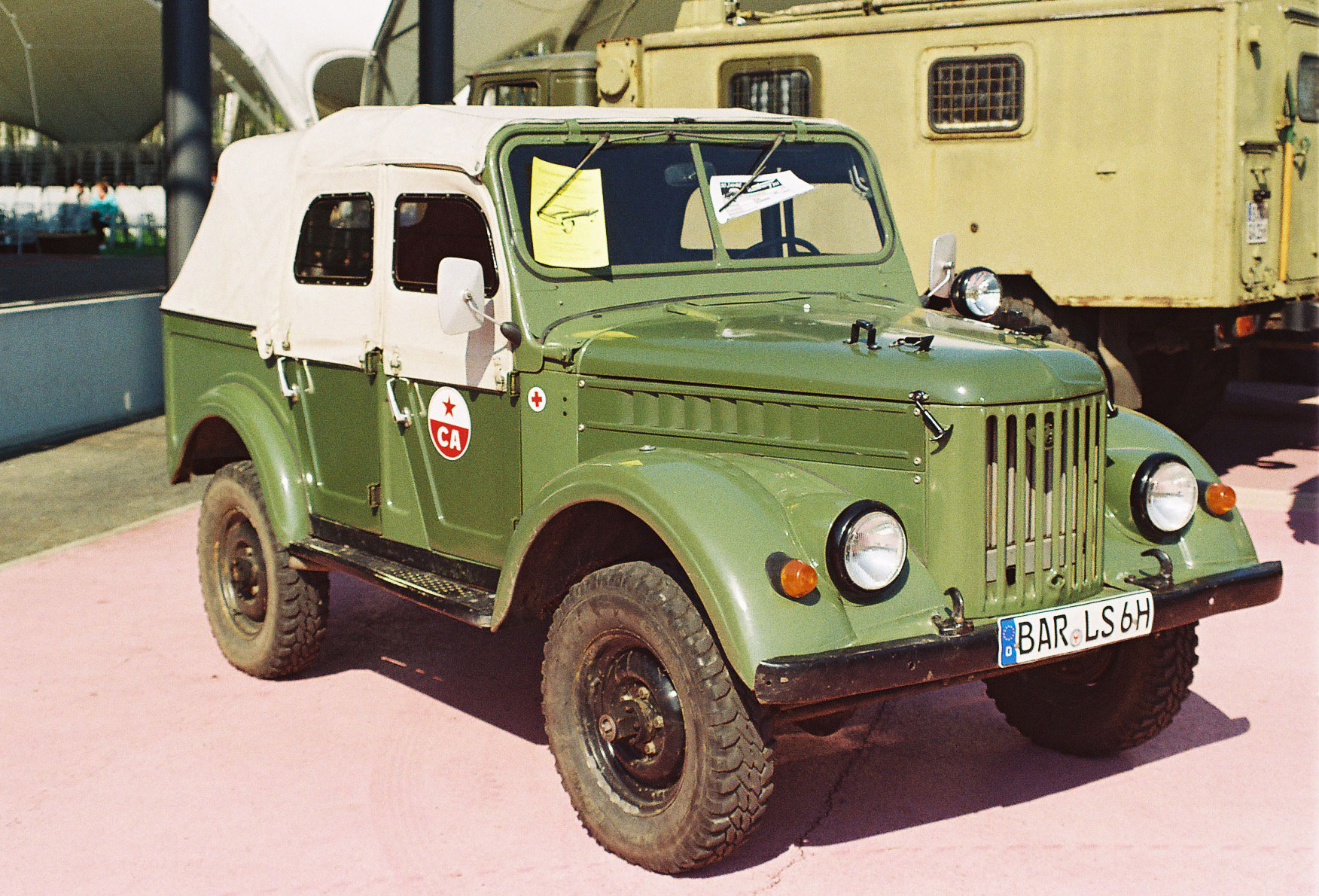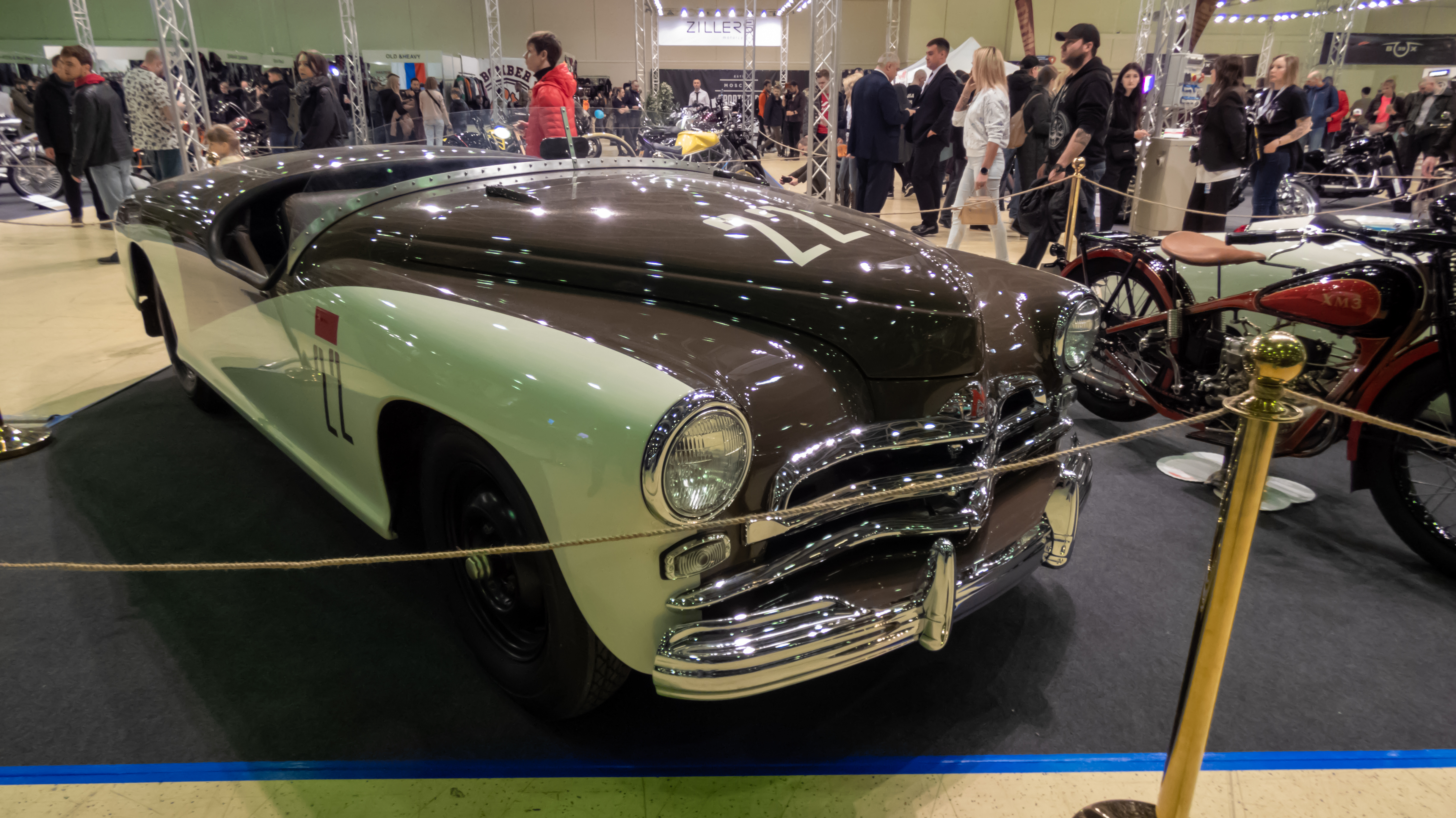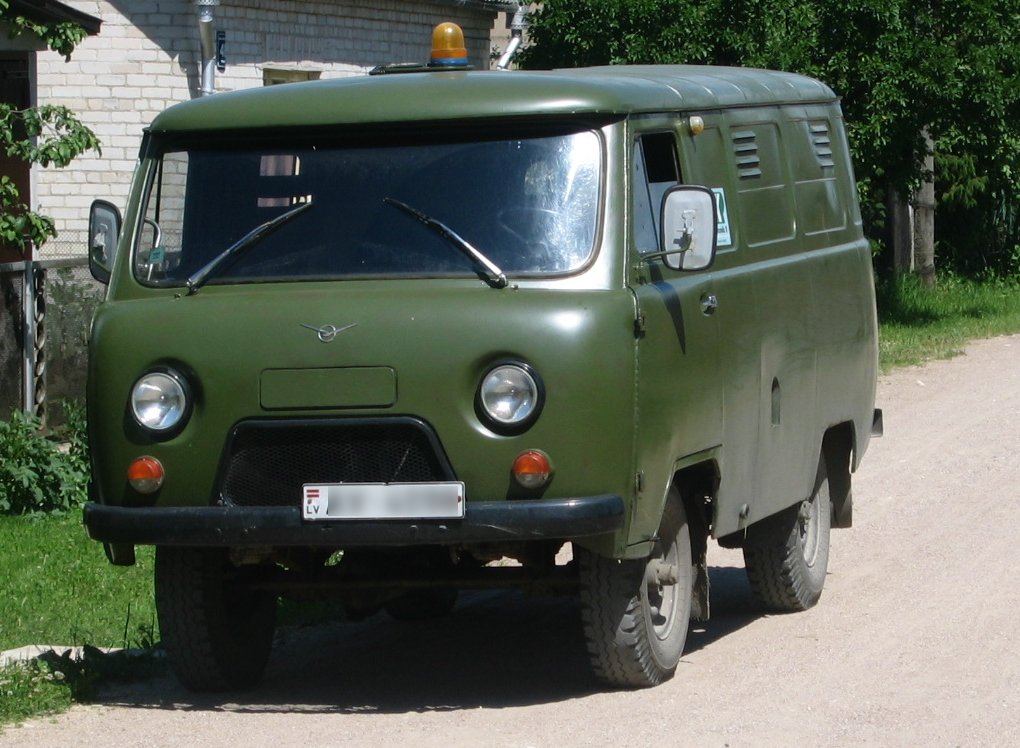|
GAZ-69
The GAZ-69 is a four-wheel drive off-road vehicle produced by GAZ (ГАЗ, or ''Gorkovsky Avtomobilnyi Zavod'', Gorky Automobile Factory) between 1953 and 1956 and then by UAZ, in 1956–1972, though all of these light truck class vehicles were known as GAZ-69s. It was also produced in Romania until 1975.Thompson, Andy. ''Cars of the Soviet Union'' (Haynes Publishing, Somerset, UK, 2008), p. 70. Development and production The GAZ-69 was created by the team of chief designer Grigoriy Vasserman as a replacement for the GAZ-67B that would have lower fuel consumption than its predecessor and use the same inline four and three-speed transmission as the GAZ-M20 ''Pobeda''. The development process started in 1946 and the first prototypes known under the name "Truzhenik" (Toiler) were built in 1947. After extensive on-road testing, the new off-road vehicle went into production on August 25, 1953. Over 600,000 GAZ-69s had been built by the end of production in the USSR in 1972. a copy ... [...More Info...] [...Related Items...] OR: [Wikipedia] [Google] [Baidu] |
UAZ-469
The UAZ-469 is an off-road military light utility vehicle manufactured by UAZ. It was used by Soviet and other Warsaw Pact armed forces, as well as paramilitary units in Eastern Bloc countries. In the Soviet Union, it also saw widespread service in state organizations that needed a robust and durable off-road vehicle. Standard military versions included seating for seven personnel. History Developed from the GAZ-69, UAZ-471 and UAZ-460, the UAZ-469 was introduced in 1971 to replace the GAZ-69. It is powered by the same UMZ-452MI inline-four engine as the UAZ-452 and is able to run on gasoline with an octane rating as low as 72 (although 76 was preferred). The UAZ-469 presented two great advantages: it was able to drive in virtually any terrain and it was very easy to repair. The vehicle was originally not available for purchase by the public, but many were sold as surplus to private owners. Modifications include a basic UAZ-469B with ground clearance of , and a specialize ... [...More Info...] [...Related Items...] OR: [Wikipedia] [Google] [Baidu] |
GAZ-46
The GAZ-46, army designation MAV (Russian, малый автомобиль водоплавающий, ''small floating car''), is a Soviet-made light four-wheel drive amphibious military vehicle that entered service in the 1950s and has been used by many Eastern Bloc allied forces since. During the Second World War Canada, Britain and the US forwarded large quantities of military materials to Russia. Among those were jeeps, trucks, and amphibious vehicles like the 6×6 DUKW and the 4×4 Ford GPA. The latter were used to help men and equipment get across the many rivers of Eastern Europe and combat the Germans. Seeing merits of such vehicles, after the war, Russia decided to develop two similar vehicles, using domestic automotive parts, the BAV, an equivalent of the DUKW, and the MAV, an equivalent of the Ford GPA. Due to bad reception of the Ford GPA 'Seep' by Allied soldiers, most of them were routed to Russia under the US Lend-Lease program, before production was halted prema ... [...More Info...] [...Related Items...] OR: [Wikipedia] [Google] [Baidu] |
GAZ-M20
The GAZ-M20 "Pobeda" (russian: ГАЗ-М20 Победа; ''победа'' means ''victory'') was a passenger car produced in the Soviet Union by GAZ from 1946 until 1958. It was also licensed to the Polish Passenger Automobile Factory and produced as the FSO Warszawa. Although usually known as the GAZ-M20, an original car's designation at that time was just M-20: M for "Molotovets" (the GAZ factory was named after Vyacheslav Molotov). History The first sketches of similar-looking cars were completed by Valentin Brodsky in 1938 and by Vladimir Aryamov in 1940, which revealed a growing tendency towards streamlined car design in the Soviet Union. Aryamov's two-door coupe GAZ-11-80, designed in 1940, greatly resembled the later Pobeda and was in many ways identical to it. However, after the German invasion of 1941 military priorities delayed the work on the new car and the factory was switched to military production. The first Pobeda was developed in the Soviet Union under chief engin ... [...More Info...] [...Related Items...] OR: [Wikipedia] [Google] [Baidu] |
GAZ-67
The GAZ-67 and the GAZ-67B (from January 1944) were general-purpose four-wheel drive Soviet military vehicles built by GAZ starting in 1943. By the end of the war, it was the Soviet equivalent of the World War II jeep. The GAZ-67 was a further development of the earlier GAZ-64 The GAZ-64 was a 4x4 vehicle made by GAZ (Gorkovsky Avtomobilny Zavod, translated as Gorky Automobile Plant, which originally was a cooperation between Ford and the Soviet Union), succeeding the earlier GAZ-61. Its design was led by Vitaliy Gr .... A main improvement was a wider track of 1446 mm. It also had a strengthened chassis frame, enlarged fuel tank and other improvements. It was powered by a slightly more powerful version of GAZ M1 4-cylinder 3280 cc gasoline motor, and had a top speed of . Production started on 23 September 1943 (the first serial vehicle produced). From January 1944 it was replaced by the GAZ-67B, which had further mechanical improvements. Sources * Evgeniy Prochko, ''V ... [...More Info...] [...Related Items...] OR: [Wikipedia] [Google] [Baidu] |
3M6 Shmel
The 3M6 ''Shmel'' (russian: 3М6 «Шмель»; en, bumblebee) is an MCLOS wire-guided Anti-tank missile of the Soviet Union. Its GRAU designation is "3M6" and its NATO reporting name is AT-1 Snapper. Too large to be manportable, it was typically deployed from specialised vehicles or helicopters. The missile was intended to supplement traditional anti-tank weapons, like the 100 mm anti-tank gun whose accuracy beyond 1,500 m is poor. The missile's accuracy in contrast remained high as far as its maximum range of 2,000 m. However, the system's bulk, slow speed and poor combat accuracy drove development of later SACLOS systems, like the AT-5 Spandrel. Development The 3M6 ''Shmel'' was based on the western ATGMs of the time, such as the Nord Aviation SS.10; however, it is considerably larger. It was developed by the Special Mortar Design Bureau (SKB Gladkostvolnoi Artillery) in Kolomna, who were also responsible for the AT-3 Sagger. Development of the missile proceeded rapidl ... [...More Info...] [...Related Items...] OR: [Wikipedia] [Google] [Baidu] |
Off-road Vehicles
An off-road vehicle, sometimes referred to as an overland or adventure vehicle, is considered to be any type of vehicle which is capable of off-roading, driving on and off Pavement (material), paved or gravel surface. It is generally characterized by having large tires with deep, open treads, a flexible suspension (vehicle), suspension, or even caterpillar tracks. Other vehicles that do not travel on public streets or highways are generally termed off-highway vehicles, including tractors, forklifts, Crane (machine), cranes, backhoes, bulldozers, and golf carts. Off-road vehicles have an enthusiastic following because of their versatility. Several types of motorsports involve racing off-road vehicles. The most common use of these vehicles is for tourism, sightseeing in areas distant from the Pavement (material), pavement. The use of higher clearance and higher traction vehicles enables access on trails and forest roads that have rough and low traction surfaces. Off-road vehicles ... [...More Info...] [...Related Items...] OR: [Wikipedia] [Google] [Baidu] |
Stoewer
Stoewer was a German automobile manufacturer before World War II whose headquarters were in Stettin (Now Szczecin, Poland). History The first company was founded by the Stoewer brothers, Emil (lived 1873 - 1942) and Bernhard (1875 - 1937) in 1896 for manufacturing sewing machines in Stettin. In 1899, the Stoewer brothers founded the firm ''Gebrüder Stoewer, Fabrik für Motorfahrzeugen'' and started to produce automobiles. Their first automobile was the Großer Stoewer Motorwagen, with 6.5 hp (4.8 kW) and maximum speed. In 1908 Stoewers constructed the ''Stoewer G4''. This model was successful for them at the time - 1070 cars were built. In 1910, Stoewer cars were built under licence by Mathis of Strassburg. In 1916, the family-owned company was transformed into a limited company under the name of ''Stoewer-Werke AG, vormals Gebrüder Stoewer''. In the mid-20s a new class of cars was introduced: the ''D-Types'' included ''D3'', ''D9'' and ''D10'' with four-cyl ... [...More Info...] [...Related Items...] OR: [Wikipedia] [Google] [Baidu] |
ARO IMS
The ARO M461 was an off-road vehicle built in post World War II Romania by ARO. IMS-57 The first model was IMS-57, named by the factory initials (Intreprinderea Metalurgică de Stat) and the year it was released. A total of 914 vehicles were built between 1957 and 1959, mostly handcrafted. During World War II, on the site of a paper plant belonging to Letea company from Câmpulung-Muscel, the production of plane propellers and shooting equipment for airplanes produced by IAR Brașov was organized. After the production was abandoned, a group of workers begun building the first Romanian motorcycles in 1953. The design (from Russian GAZ 69 The GAZ-69 is a four-wheel drive off-road vehicle produced by GAZ (ГАЗ, or ''Gorkovsky Avtomobilnyi Zavod'', Gorky Automobile Factory) between 1953 and 1956 and then by UAZ, in 1956–1972, though all of these light truck class vehicles were ...) and production of the first Romanian all-terrain vehicle IMS-57 began in 1957, using the parts t ... [...More Info...] [...Related Items...] OR: [Wikipedia] [Google] [Baidu] |
UAZ-452
The UAZ-452 "Bukhanka" ('Буханка' or ' ''bread loaf''') are a family of compact Russian cab over engine vans and light trucks with standard four-wheel drive, off-road capability, built by the Ulyanovsk Automobile Plant (UAZ) since 1965. The vans got their nickname due to their outer resemblance to a loaf of bread – except the ambulance version, which gets called a "Tabletka" ('Таблетка'), or 'pill' in Russian. Since 1985, the vans received updates: more modern engines and internationally compliant lighting, as well as new model numbers, 3741 for the standard van, while (crew-cab) trucks mostly starting with 3303, often with one or two extra digits specifying the version. From 1997, bigger 33036 truck variants with a 25 cm (10 in) longer wheelbase, and taller soft-top roof bows and drop-sides were added. Overview The model's predecessor, the UAZ-450 (produced between 1958 and 1966), was based on the chassis and engine of the four-wheel drive light ... [...More Info...] [...Related Items...] OR: [Wikipedia] [Google] [Baidu] |
Four-wheel Drive
Four-wheel drive, also called 4×4 ("four by four") or 4WD, refers to a two-axled vehicle drivetrain capable of providing torque to all of its wheels simultaneously. It may be full-time or on-demand, and is typically linked via a transfer case providing an additional output drive shaft and, in many instances, additional gear ranges. A four-wheel drive vehicle with torque supplied to both axles is described as "all-wheel drive" (AWD). However, "four-wheel drive" typically refers to a set of specific components and functions, and intended off-road application, which generally complies with modern use of the terminology. Definitions Four-wheel-drive systems were developed in many different markets and used in many different vehicle platforms. There is no universally accepted set of terminology that describes the various architectures and functions. The terms used by various manufacturers often reflect marketing rather than engineering considerations or significant technical diff ... [...More Info...] [...Related Items...] OR: [Wikipedia] [Google] [Baidu] |
Indonesian Air Force
The Indonesian Air Force ( id, Tentara Nasional Indonesia Angkatan Udara (TNI-AU), literally "''Indonesian National Military-Air Force''") sometimes shortened as IDAF / IdAF, is the aerial branch of the Indonesian National Armed Forces. The Indonesian Air Force is headquartered in Jakarta, Indonesia and is headed by the Chief of Staff of the Air Force ( id, Kepala Staf Angkatan Udara – KSAU or KASAU). Its order of battle is split into three Air Operations Commands ( id, Komando Operasi Udara). Most of its airbases are located on the island of Java. The Indonesian Air Force also has its ground force unit, called Air Force Quick Reaction Force Command (Kopasgat). The corps is also known as the "Orange Berets" () due to the distinctive color of their service headgear. The Indonesian Air Force has 37,850 personnel and equipped with 110 combat aircraft. The inventory includes five Su-27 and eleven Su-30 as the main fighters (from Russia) supplemented by 33 F-16 Fighting Falco ... [...More Info...] [...Related Items...] OR: [Wikipedia] [Google] [Baidu] |
Indiana Jones And The Kingdom Of The Crystal Skull
''Indiana Jones and the Kingdom of the Crystal Skull'' is a 2008 American action-adventure film directed by Steven Spielberg and the fourth installment in the ''Indiana Jones'' series. Released and taking place 19 years after the previous film, it is set in 1957, pitting Indiana Jones (Harrison Ford) against Soviet KGB agents led by Irina Spalko (Cate Blanchett)—searching for a telepathic crystal skull. Jones is aided by his former lover, Marion Ravenwood ( Karen Allen), and their son, Mutt Williams ( Shia LaBeouf). Ray Winstone, John Hurt, and Jim Broadbent are also part of the supporting cast. Screenwriters Jeb Stuart, Jeffrey Boam, Frank Darabont, George Lucas and Jeff Nathanson wrote drafts before David Koepp's script satisfied the producers. The filmmakers intended to pay tribute to the science fiction B-movies of the 1950s era. Shooting began on June 18, 2007, at various locations in New Mexico, New Haven, Connecticut, Hawaii, and Fresno, California, as w ... [...More Info...] [...Related Items...] OR: [Wikipedia] [Google] [Baidu] |







